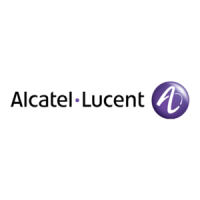T1 Interface Overview
Except on the first page, right running head:
Heading1 or Heading1NewPage text (automatic)
271
Alcatel-Lucent
Beta Beta
OmniAccess 5740 Unified Services Gateway CLI Configuration Guide
T1 INTERFACE OVERVIEW
The T1 interface provides a transmission rate of 1.544 Mbps. It can support up to
24 user channels, each at a 64 Kbps access rate. The T1 interface supports 4
different bit structures, dictated by the mode of operation: Frame, Super Frame,
Extended Super Frame, and Unframed.
These bit structures determine how the bits are interpreted. A T1 basic frame is
made up of 24 timeslots plus 1 framing bit added to them. Each timeslot is
regarded as a channel of 64 Kbps bandwidth. The frame length is 193 bits
(24*8 + 1). A framing bit creates a channel of 8 Kbps and is used for messages,
synchronization and alarms.
The following sections detail sequence of commands to configure a T1 line card:
• “Frame Formats Used in T1 Cards”
• “T1 Modes of Operation”
FRAME FORMATS USED IN T1 CARDS
The T1 standard defines two frame formats, as described below.
T
HE SUPER FRAME (SF)
A Superframe is a structure constructed of 12 Frames, numbered 1 - 12. It is also
called as the D4 frame. Two mechanisms can be activated using SF's
synchronization mechanism, which is always activated, and signaling mechanism,
which is optional.
• The synchronization mechanism - The 12 framing bits, which are the leading
bits of each frame in one SF form a unique pattern. With this pattern,
synchronization is achieved and verified (it is used to identify the frame
boundaries and theSF boundaries).
• The signaling mechanism - If CAS is in use, every 6th frame in the SF contains
one "robbed" bit in each byte of information (channel). This "robbed" bit carries the
information of this specific channel. The last bit of each TS is "robbed" for the
purpose of signaling. These "robbed" bits form a channel with capacity of 10.666
Kbps. If CCS is in use, then one Timeslot (TS), usually TS 24, is dedicated for
signaling purposes.

